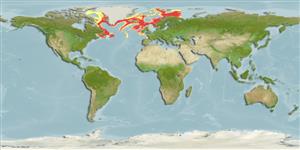Elasmobranchii (haaien en roggen) (sharks and rays) >
Rajiformes (Skates and rays) >
Rajidae (Skates)
Etymology: Rajella: Latin, raja, -ae = a sting ray (Raja sp.) (Ref. 45335); fyllae: Named after Douglas F. Markle who collected and provided the specimens (Ref. 31389).
More on author: Lütken.
Environment: milieu / climate zone / depth range / distribution range
Ecologie
marien bathydemersaal; diepte 147 - 2055 m (Ref. 106604), usually 300 - 800 m (Ref. 3167). Deep-water; 1°C - 7°C (Ref. 117245); 84°N - 40°N, 75°W - 55°E (Ref. 114953)
North Atlantic and adjacent fringes of the Arctic Region: offshore of Gulf of Maine and slopes off Newfoundland banks and Labrador to southern Baffin Bay, around southern Greenland to Denmark Strait, south of Iceland, and along Faroe-Shetland ridge to the Skagerrak; west of British Isles from Porcupine Bank and Rockall Plateau to Faroe Islands; and off Norwegian coasts to western Barents Sea and Svalbard.
Grootte / Gewicht / Leeftijd
Maturity: Lm ? range ? - ? cm
Max length : 60.0 cm TL mannelijk / geslacht onbekend; (Ref. 35388)
Korte beschrijving
Morfologie | Morfometrie
Snout is short and obtuse. Midbelt of its disc and upper surface of its tail are rough with large thorns in irregular rows. Upper surface ash gray to chocolate brown. Lower surface white, grayish white, pale gray or light fawn color, sooty patches on pelvic fins and axils of pectoral fins (Ref. 6902).
Found in deeper shelf and slope waters, in 3-5.5°C water temperature (6902). Benthic (Ref. 58426). Feed on all kinds of bottom animals with preference for invertebrates (Ref. 3167) like copepods, amphipods and mysids (Ref. 6902). Oviparous. Distinct pairing with embrace. Young may tend to follow large objects, such as their mother (Ref. 205). Eggs are oblong capsules with stiff pointed horns at the corners deposited in sandy or muddy flats (Ref. 205). Egg capsules are 3.8-4.2 cm long and 2.4-2.6 cm wide (Ref. 41303, 41251, 41301). It is captured at low level by-catch in bottom-trawl and longline fisheries (Ref. 117245).
Levenscyclus en paargedrag
Maturiteit | Voortplanting | Paaien | Eieren | Fecunditeit | Larven
Oviparous, paired eggs are laid. Embryos feed solely on yolk (Ref. 50449). Distinct pairing with embrace. Young may tend to follow large objects, such as their mother (Ref. 205).
McEachran, J.D. and K.A. Dunn, 1998. Phylogenetic analysis of skates, a morphologically conservative clade of elasmobranchs (Chondrichthyes: Rajidae). Copeia 1998(2):271-290. (Ref. 27314)
Status op de Rode Lijst van het IUCN (Ref. 130435)
Gevaar voor de mens
Harmless
Gebruik door de mens
Visserij: van geen belang
Meer informatie
ReferentiesAquacultuurAquacultuurprofielKweeklijnenGeneticaElectrophoresesErfelijkheidZiektesVerwerkingNutrientsMassaconversie
Tools
Speciale rapporten
Download XML
Internetbronnen
Estimates based on models
Preferred temperature (Ref.
123201): 0.7 - 9.5, mean 3.6 °C (based on 707 cells).
Fylogenetische diversiteitsindex (Ref.
82804): PD
50 = 0.5000 [Uniqueness, from 0.5 = low to 2.0 = high].
Bayesian length-weight: a=0.00302 (0.00141 - 0.00645), b=3.24 (3.07 - 3.41), in cm total length, based on LWR estimates for this (Sub)family-body shape (Ref.
93245).
Trofisch niveau (Ref.
69278): 3.4 ±0.2 se; based on diet studies.
Weerstandsvermogen (Ref.
120179): laag, minimale populatieverdubbelingstijd 4,5-14 jaar (Fec assumed to be <100).
Fishing Vulnerability (Ref.
59153): Moderate vulnerability (44 of 100).
Nutrients (Ref.
124155): Calcium = 5.49 [0.80, 107.06] mg/100g; Iron = 0.328 [0.031, 4.452] mg/100g; Protein = 15.1 [13.0, 17.1] %; Omega3 = 0.494 [0.195, 1.253] g/100g; Selenium = 17.8 [3.1, 85.5] μg/100g; VitaminA = 4.75 [0.34, 63.37] μg/100g; Zinc = 0.305 [0.021, 3.468] mg/100g (wet weight);
